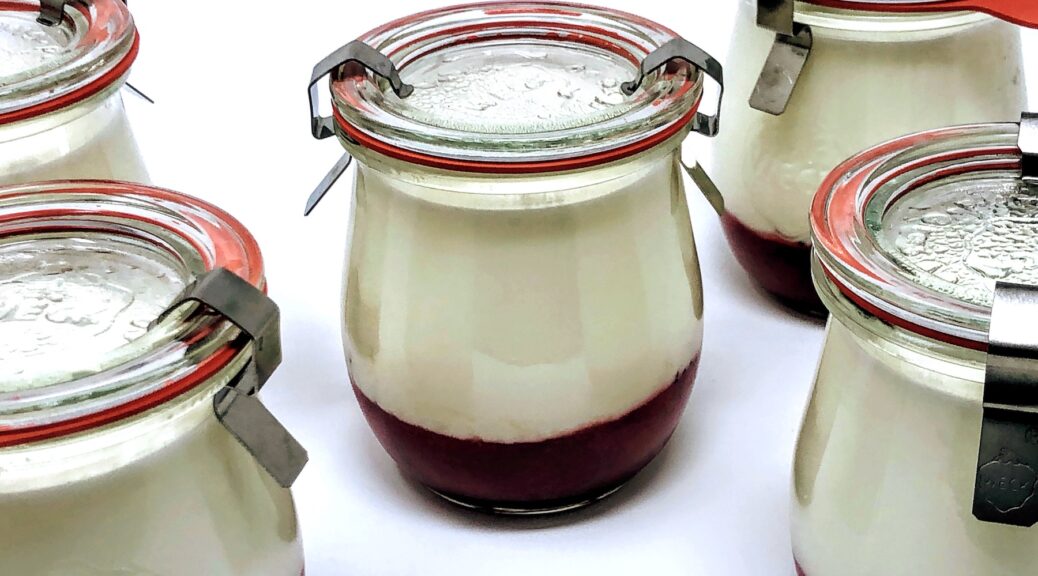The yogurt pictured includes a fruit compote on the bottom, which is fantastic but not necessary. Another great way to add to this is topping with about 2 tbsp of granola or a teaspoon of honey.
The keys to homemade yogurt are to use the right ingredients and the right equipment for the right process. Ok, that’s true of any food, more or less. So what are the right versions of each?
- Milk: The best milk is a non-homogenized, pasteurized whole milk. Ultra-pasteurized may not work well at all. And non-homogenized is fine, but appears to produce a less thick yogurt. And why would you use anything thinner than whole milk?
- Starter: The best starter is one you’ve been culturing over time by saving a few tablespoons of each batch for use in the next batch, within about 2-3 weeks. If that starter does not seem to be working, you may need to try again with a new starter. If you’re buying a new starter, you have two big options. 1) Purchase a dry starter and follow the directions. 2) Purchase a plain, unsweetened full-fat yogurt. Find the best quality you can for that starter yogurt and it could last you a long time. I trust Straus yogurt anytime I need a starter because it does not contain thickeners.
- Tools: Instant Pot does a fantastic job here. And these 762 Weck jars are the perfect size for a single serving. 2 Quarts of whole milk fill 10 of these jars to about the ¾ mark, with a few tablespoons leftover for culturing next time.
Homemade Yogurt
Simple, inexpensive and low-waste breakfast
Prep Time30 minutes mins
Cook Time6 hours hrs
Total Time6 hours hrs 30 minutes mins
Course: Breakfast
Cuisine: Simple
Keyword: Fermentation
Servings: 10 servings
Calories: 115kcal
- 2 quarts whole milk
- 2 tbsp yogurt starter
- 4 cups ice for cooling
First, pour the milk into the inner pot of the Instant Pot. Turn the Instant Pot to the "High" Yogurt setting, which will bring the yogurt to boiling temperature for 1 minute and then end. This takes about 10-20 minutes, though I've never timed it. Keep covered and stir occassionally with a very clean instrument (not wood – use either metal or silicone).
While that happens, prepare an ice bath to cool the yogurt by adding ice to a very large bowl.
Once milk has boiled, remove the inner pot carefully and place in the ice bath. Add some cold water to allow the inner pot to submerge slightly, if needed. Stir the milk and periodically check the temperature until it reaches about 110ºF.
Remove about ½ cup of milk to a smaller bowl or 2-cup measuring cup. Add the culture and stir well until disolved. Add this back to the larger pot and stir well.
Dry the outside of the inner pot thoroughly, so as to not damage the Instant Pot. Place this back in the Instant Pot. Set the Instant Pot to medium yogurt setting and allow to ferment, with the lid on, for somewhere between 4-8 hours. With the Straus culture, after the first time, it takes about 6 hours. You are looking for the yogurt to be thick and for it pull from the sides nearly in a block if you lift and tilt the inner pot to one side. It should have a slight nearly clear, liquid layer on the top.
Cover well (consider using a sealing lid or wrap of some kind) and then place in the fridge to cool for several hours to further firm up. When cooled, transfer to the weck jars, but make sure to save at 2-3 tbsp separately for the next time you make yogurt.
Calories: 115kcal | Carbohydrates: 9g | Protein: 6g | Fat: 6g | Saturated Fat: 4g | Cholesterol: 19mg | Sodium: 86mg | Potassium: 250mg | Sugar: 10g | Vitamin A: 307IU | Calcium: 217mg | Iron: 1mg
Nutrition Facts
Homemade Yogurt
Amount Per Serving
Calories 115
Calories from Fat 54
% Daily Value*
Fat 6g9%
Saturated Fat 4g25%
Cholesterol 19mg6%
Sodium 86mg4%
Potassium 250mg7%
Carbohydrates 9g3%
Sugar 10g11%
Protein 6g12%
Vitamin A 307IU6%
Calcium 217mg22%
Iron 1mg6%
* Percent Daily Values are based on a 2000 calorie diet.
